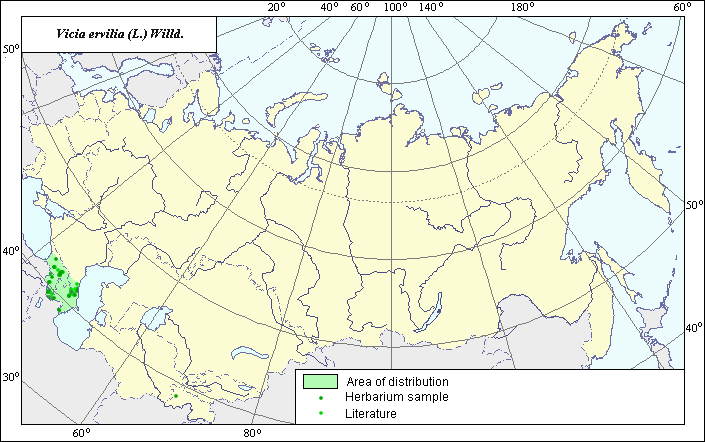Relatives
Area of bitter vetch (Vicia ervilia L.).
 Object description Download GIS-layers
Object description Download GIS-layers
Authors:
The experts - Dzyubenko N. I., E. A. Dzyubenko.The GIS-Expert - Dzyubenko A. N.
Date of creation:
17.09.2004.Scale:
1:20 000 000.Exactness of a map:
The map was created using maps that had the following scale 1:10 000 000.The projection:
"Alber's Equal Area Conic for Russia", 9, 1001, 7, 100, 0, 44, 68, 0, 0.Basic contents:
Map is a vector file consisting of polygons and points. Locations of species are represented by points, area of possible distribution of species are represented by polygons.Exactness of classifier:
Light-colored points are locations referenced in literature sources. Dark-colored points are locations of the species that were as reported from created database VIR (N.I.Vavilov All-Russian Research Institute of Plant Industry) and BIN (the Komorov Institute of Botany).Polygons are based on literature sources, herbarium samples, political boundaries and ecological description.Method of map construction:
For construction of the area of Vicia ervilia the herbaria data (N.I. Vavilov All Russian Institute of Plant Industry (VIR), Komarov Botanical Institute (BIN), St.-Petersburg) and published map of the part of the area (Grossheim, 1952) were used. Point area of Vicia ervilia includes mainly locations of the species identified on the base of VIR and BIN herbarium. The species has originated from the territories of Mediterranean Basin, Middle, Minor and South-Western Asia. Its locations at the Caucasian territory represent the north-eastern part of natural area of the species (Flora of USSR, 1948). The southern part of final area at the territory of Central Asia appears to have secondary origin and has formed as a result of introduction, men activity and naturalization (Flora of cultivated plants, 1999). Final area has the disjunctive character and consists of three polygons (green line) and separate points.In the definition of the border of the area we took into account all available literary data (Flora of the USSR, 1948; Flora of Uzbekistan, 1955; Flora of Kazakhstan, 1961; Flora of Tadzhikistan, 1978; Brezhnev , Korovina, 1980; Nikitin, Geldikhanov, 1988) which had no significant contradictions. The points, which were not included into borders of contours, represented invasive sites of species.Sources of the data:
Brezhnev D. D., Korovina O. N. 1980. Wild relatives of the cultivated plants of flora of the USSR. - L.: Kolos, 376 pp. (in Russian).Flora of cultivated plants. Vicia. 1999. Repjev S. I. (ed.). - SPb.: VIR, Vol. IV, part 2 - 492 pp. (in Russin).
Flora of Kazakhstan. 1961. Pavlov N. B. (ed.). - Alma - Ata: AN KazSSR, Vol. V. - 515 pp. (in Russian).
Flora of Tadzhikistan. 1978. Ovchinnikov P. N. (ed.). - L.: Nauka, Vol. V. - 678 pp. (in Russian).
Flora of the USSR. Genus Vicia. 1948. Schischkin V.K., E.G. Bobrov (ed.). Vol. XIII, M.-L.: AN USSR , p. 406 - 475. (in Russian).
Flora of Uzbekistan. 1955. Korovin E. P (ed.). - Tashkent: AN UzSSR, Vol. III. - 825 pp.(in Russian).
Grossheim A. A. 1952. Genus Vicia. Flora of the Caucasus. - M. - L.: Academy of Science of the USSR, Vol. V. - p. 380 - 398. (in Russian).
Nikitin V. V., Geldikhanov A. M.. 1988. Plants of Turkmenistan. A field guide. - L.: Nauka, 680 pp. (in Russian).
Created database of the VIR materials (N. I. Vavilov Allrussian Institute of Plant Industry)and BIN materials (the Komorov Institute of Botany).
Rights and copyrights:
Copyright on the map and descriptions belong to its authors.Copyright on the photos belong to Dzyubenko N. I.

